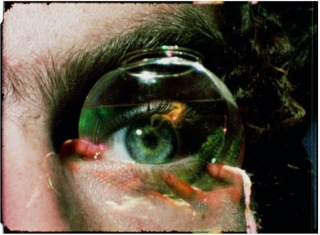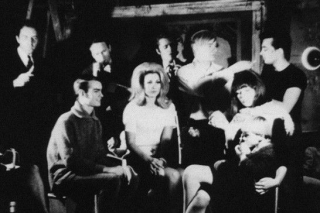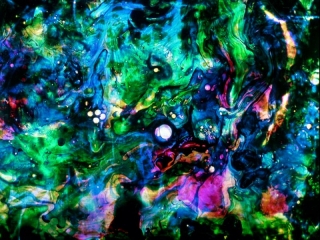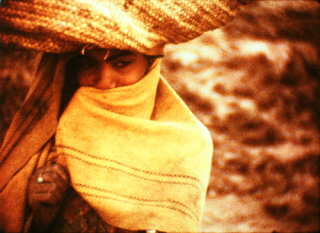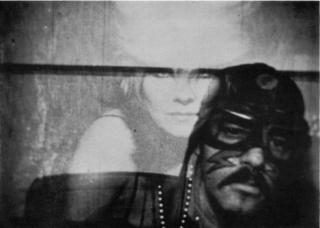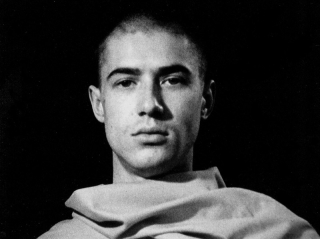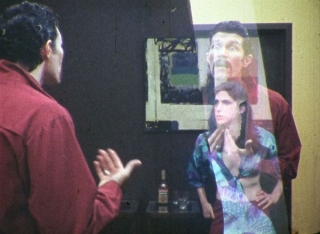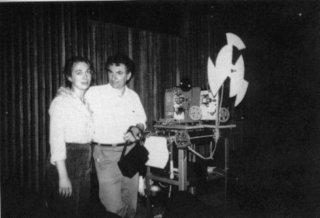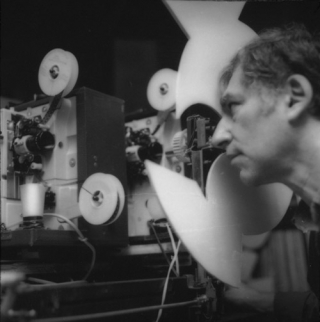Date: 15 October 1999 | Season: Leeds Film Festival 1999
AMERICAN UNDERGROUND PRIMER: 1
Friday 15 October 1999, at 6pm
Leeds Hyde Park Cinema
Maya Deren, Meshes of the Afternoon, 1943, 18 min
The making of Maya Deren’s first film was a key point in the advancement of the personal film. It is one of the earliest ‘trance’ films, a style which developed from the earlier European Surrealist films of the 1920s and 30s. Deren creates a subconscious world and portrays a dreamer disturbed by a series of irrational incidents.
Kenneth Anger, Invocation of My Demon Brother, 1969, 11 min
Kenneth Anger, one of the most well-known experimental filmmakers, fuses the magick of his mentor Aleister Crowley with the myths of Hollywood’s golden age. This film, which shows Anger performing the Equinox Of The Gods ritual and has a Moog synthesiser soundtrack by Mick Jagger, is one of his most intense productions.
Ken Jacobs, Little Stabs at Happiness, 1959-63, 15 min
Little Stabs at Happiness consists of several unedited camera poems which depict a wistful nostalgia for times passed. Two sections feature the legendary filmmaker and performer Jack Smith. Ken Jacobs went on to be an important influence on the Structural movement and since the 1970s has developed amazing 3D projection performances known as the Nervous System.
Paul Sharits, Piece Mandala/End War, 1966, 3 min
Paul Sharits produced a series of outstanding ‘flicker’ films in which rapid changes of colour result in perceptual hallucinations. Piece Mandala/End War is a concise and remarkable example of his stroboscopic style.
Shirley Clarke, Bridges Go Round, 1958, 8 min
Shots of immobile New York bridges are choreographically edited and printed in a way such that they appear to dance. The footage is repeated twice, once with a score by jazz arranger Teo Macero and again with a composition by electronic music pioneers Louis and Bebe Barron (best known for their soundtrack to The Forbidden Planet).
Bruce Baillie, Mass (for the Dakota Sioux), 1964, 24 min
A sombre examination of the American experience and a critique of modern society. Baillie masterfully combines footage from television, movies, film diaries and specially staged scenes to present a densely layered requiem dedicated to the Native American Indians.
Robert Breer, 69, 1968, 5 min
Robert Breer, whose films present continually evolving ideas in a witty, gentle style, is one of the most original and respected animators of the experimental movement. 69 is a kinetic investigation of geometric forms, building visual tension by rapidly alternating images.
Robert Nelson, Oh Dem Watermelons, 1965, 12 min
A classic underground romp starring the San Francisco Mime Troop and a dozen watermelons. The fruit is put through every possible use and treatment for comic effect and social comment. Minimalist composer Steve Reich arranged the soundtrack.
Back to top
Date: 16 October 1999 | Season: Leeds Film Festival 1999
AMERICAN UNDERGROUND PRIMER: 2
Saturday 16 October 1999, at 6pm
Leeds The Fruit Cupboard
Scott Bartlett, OffOn, 1968, 9 min
Scott Bartlett was one of the first filmmakers to utilise the newly developed video technology in his work. OffOn evolved in an audio-visual jam session and is a virtuoso display of image and sound processing.
Ian Hugo, Bells of Atlantis, 1952, 10 min
An impressionist cine-poem providing visual accompaniment to “The House of Incest”, which is read by its author Anais Nin. The magical fusion of image, text and sound vividly depicts the sunken city of the subconscious. Produced with technical assistance from Len Lye and an electronic soundtrack by the Barrons.
Jonas Mekas, Award Presentation to Andy Warhol, 1964, 12 min
Mekas, the irrepressible force behind the promotion and preservation of experimental film, is also known for his rapid-fire diary films. Award Presentation to Andy Warhol documents Mekas giving Warhol (and Factory superstars Gerard Malanga, Baby Jane Holzer and Ivy Nicholson) the Film Culture Sixth Independent Film Award. In contrast to his regular shooting style, Mekas, assisted here by Gregory Markopoulos, uses one long take to replicate Warhol’s own techniques.
Hy Hirsh, Autumn Spectrum, 1957, 6 min
The mysterious Hy Hirsh made a handful of freewheeling abstract compositions throughout the 1950s. This film contrasts sumptuous impressions of Amsterdam canals with a soundtrack by the Modern Jazz Quartet.
Owen Land (formerly known as George Landow), The Film that Rises to the Surface of Clarified Butter, 1968, 9 min
One of the forerunners of the structural movement, Land has made several witty and confusing films that question the materials and methods of filmmaking. The Film that Rises to the Surface of Clarified Butter depicts animated figures that have a life of their own but exist in the same space as their creator.
James Whitney, Lapis, 1963-66, 9 min
James Whitney, one of the pioneers of computer animation, presents a constantly evolving mandala image as a highly psychedelic meditation tool.
George Kuchar, Hold Me While I’m Naked, 1966, 15 min
The Kuchar Brothers’ films are no-budget homages to Hollywood, which depict their own mundane lives as glamorous Technicolor dramas. Hold Me While I’m Naked is a hilarious parody of the frustration and loneliness of a Bronx filmmaker who thinks everyone is having a more exciting, sexier time than he.
Larry Jordan, Duo Concertantes, 1964, 9 min
Larry Jordan became known for constructing exquisite animations from surreal Victorian engravings. This procedure generates radical juxtapositions of scale, spatial relationships and the associative qualities of objects. Rococo imagery mixes with space age symbols as a mystical lady with an orbital head moves through the carnival of life.
Tony & Beverly Conrad, Straight and Narrow, 1970, 10 min
After making The Flicker, which consists solely of alternating black and white frames, the composer Tony Conrad collaborated with his wife Beverly on Straight and Narrow. Accompanied by psychotic music from John Cale and Terry Riley, rapidly changing horizontal and vertical lines produce visual hallucinations of colour and complex patterns.
Back to top
Date: 17 October 1999 | Season: Leeds Film Festival 1999
STAN BRAKHAGE SPECIAL PROGRAMME
Leeds City Art Gallery
Sunday 17 October 1999, at 2pm
Five short films by Stan Brakhage will follow the screening of Jim Shedden’s documentary on the legendary filmmaker.
Stan Brakhage, Mothlight, USA, 1963, 4 min
Made without a camera, Mothlight was constructed by sandwiching moth wings, flowers and other organic matter between two strips of clear Mylar editing tape. This collage was then printed on 16mm film. The image, which rapidly flashes by, is regarded by the filmmaker to be “as a moth might see from birth to death if black were white”.
Stan Brakhage, Reflections on Black, USA, 1955, 12 min
The visions of a blind man depict an erotic and aesthetic quest, which transcends the distinction between fantasy and reality. This angst-ridden drama of relationships in a New York tenement building is an early example of Brakhage’s rejection of sound, which he believes interferes with the purity and clarity of vision.
Stan Brakhage, Night Music, USA, 1986, 30 sec
Stan Brakhage, Rage Net, USA, 1988, 30 sec
Stan Brakhage, Glaze of Cathexis, USA, 1990, 4 min
In recent decades, Brakhage has concentrated his efforts mainly on “moving visual thinking”, created by painting directly onto film, or physically scratching into the emulsion. Night Music was originally painted on IMAX but has unfortunately never been presented in that format. Rage Net and Glaze of Cathexis both trace psychological states through hypnotic rushes of colour and form.
Back to top
Date: 6 May 2000 | Season: Oberhausen 2000 | Tags: Oberhausen Film Festival
CAME THE LOOP BEFORE THE SAMPLER
Saturday 6 May 2000, at 10:00pm
Oberhausen Lichtburg Filmpalast
A film programme conceived as a celebration of the loop in its purest form, from the days before its inherent, repetitive beauty was abused by the talent-challenged masses of modern musicians. I oppose the use of drum loops and sampled sections “borrowed” from other people’s hard work in order to compensate for an individual’s lack of creativity. Imitation is the highest form of flattery, but only if it is done in an intelligent manner. There are clever (and respectful) ways in which to quote someone else’s material that bears no relation to using another’s talent to counteract your lack of imagination. The programme is partially conceived as an audio / visual assault on the sample-mongers, but in turn provides divine retribution for those of who appreciate the loop in it’s absolute, most crafted form.
Robert Nelson, Oh Dem Watermelons, 1965, 12 min
Peter Kubelka, Adebar, 1956-57, 1.5 min
Anthony Balch & William Burroughs, The Cut-Ups, 1967, 10 min
Keewatin Dewdney, The Maltese Cross Movement, 1967, 8 min
Joyce Wieland, 1933, 1967, 4 min
Owen Land (formerly known as George Landow), Thank You Jesus for the Eternal Present: 1, 1973, 6 min
Chris Garratt, Exit Right, 1976, 5 min
Standish Lawder, Runaway, 1969, 6 min
Malcolm Le Grice, Reign of the Vampire, 1970, 15 min
Bruce Conner, Looking for Mushrooms, 1961-67/1995, 14 min
Note: Although it was only announced as the second film in the programme, Adebar by Peter Kubelka was projected eight times, between all the other films.
PROGRAMME NOTES
CAME THE LOOP BEFORE THE SAMPLER
Saturday 6 May 2000, at 10:00pm
Oberhausen Lichtburg Filmpalast
OH DEM WATERMELONS
Robert Nelson, USA, 1965, 16mm, colour, sound, 12 min
The soundtrack to Oh Dem Watermelons was created by Steve Reich, who is now recognised as one of the first composers to use tape loops, and short repetitive phrases, in “serious” (modern classical) music. To accompany the film, Reich took a parody of a Stephen Foster song and wrote a loop into the melody. The resulting score, which is sung by a chorus of voices, repeats the “Watermelon” in the lyric in a manner which mirrors the repetitive treatment of the unfortunate fruits on the screen.
“The film cost $280 to make, including the cost of a dozen watermelons. We all had a good time running around the Mission District and Portrero Hill busting up watermelons, showing-off and having fun. A few weeks later when we had the film roughly edited, I ran it silent for Ron and Saul and a few people at the Mime Troupe. There was deadly silence and it looked awful. Everyone was embarrassed for me and didn’t know what to say. I faked it by saying it was good and not to worry. A few days later Steve Reich composed the soundtrack and got all the people to sing their parts the right way. The track has helped the film a lot. The film has won a lot of prizes all over the world … and I bought a lot of equipment with the prize money I got for it.” (Robert Nelson)
ADEBAR
Peter Kubelka, Austria, 1956-57, 35mm, b/w, sound, 1.5 min
The spectator of Peter Kubelka’s Adebar benefits greatly from repeated viewing. In fact, the filmmaker distributes both this and the related work Schwechater (1957-58), on reels containing two, five, or seven successive prints. These two short films present a highly refined, economical use of sound and image that are intricately measured against each other. To construct Adebar, Kubelka devised five self-imposed rules regarding the sequencing of the eight chosen sections (of which six have movement and two are stills) and applied these rules to the editing process. The integrated soundtrack is assembled from four twenty-six frame phrases of Pigmy music.
“In the attempt to find for film binding compositional principles of a syntactical-formal nature, Kubelka proceeds in a way analogous to music, especially Webern’s. Filmic time was conceived as ‘measurable’ in the same way as musical time; tones as ‘time-points’ became the frames of film. Just as Webern reduced music to the single tone and the interval, so Kubelka reduced film to the film-frame and the interval between two frames. Just as the law of the row and its four types determined the sequence of tones, pitches, etc., so now the sequence of frames, and of the frame-count, phrases in Vertov’s terminology, positive and negative, timbre, emotional value, silence, etc; between these factors as in serial music, the largest possible number of relationships were produced. It was for this reason that Kubelka also called these films ‘metrical films’. For the metrication of the material already established in Mosaik Im Vertrauen now became a metrication of the single frames. It passed over, so to speak (as with Webern) from the thematic organisation to the organisation of the row, and like the latter he viewed the number opf frames as a function of intervals. Adebar, a film commissioned by the bar of the same name, is the first pure Viennese formal film to be generated by these considerations.” (Peter Weibel)
THE CUT-UPS
Anthony Balch & William Burroughs, UK, 1967, 16mm, b/w, sound 10 min
The Cut Up technique, which was developed for literature by William Burroughs and Brion Gysin, was adapted and applied to film by Anthony Balch. The footage was originally shot in 1961-65 for an uncompleted film called Guerrilla Conditions, and was subsequently edited intor four separate sequences. After determining an optimum length of shot that would allow a viewer to recognise imagery without being able to interpret it, Balch instructed a lab technician to “take a foot from each roll and join them up”, making this an early (and unrecognised) Structural film. As with Oh Dem Watermelons, the soundtrack of The Cut Ups relies more on a written score than it does on a looped tape. Burroughs and Gysin read the well orchestrated, persistent text, which is based on a Scientology manual.
“The Cut Ups was a radical cinematic experiment; primarily this was due to its re-negotiation of the ontology of film. The process of viewing The Cut Ups is analogous to the process of viewing the Dreamachine; like the Dreamachine the film creates a rhythmic pattern of flickering light and images across the audience’s retinas; as Ian Sommerville noted, “Flicker may play a part in cinematic experience. Films impose external rhythms on the mind, altering the brain waves which are otherwise as individual as finger-prints”. The Cut Ups presented images which were simultaneously at random, yet precise, with scenes structured according to lengths of celluloid rather than of action or narrative. The only order imposed on the film is that which attempts to remove coherent, linear, narrative structure. The film demands that an audience experience film differently: as pure light and motion. Devoid of ‘rational logic’, conventional narrative, and recognisable visual pleasure; instead The Cut Ups constructs the audience’s relation with film as one based on the aesthetic of pure speed, as images strobe past the audience’s collective retina.” (Jack Sargeant)
THE MALTESE CROSS MOVEMENT
Keewatin Dewdney, Canada, 1967, 16mm, colour, sound, 8 min
A loop of the Beach Boys’ song “Gettin’ Hungry” from the “Smiley Smile” album provides an aural background to this cleverly constructed work by an undervalued Canadian filmmaker. One aspect of the film is concerned with using pictures to visually represent words, in a manner comparable to Associations (1975) by English filmmaker John Smith. As a result of the reorganisation of fragments of sound and imagery from throughout the film, the viewer suddenly becomes aware of an emerging objective, which triumphantly comes together in the final montage.
The film reflects Dewdney’s conviction that, “the projector, not the camera, is the filmmaker’s true medium”. The form and content of the film are shown to derive directly from the mechanical operation of the projector – specifically the animation of the disk and the cross illustrates graphically (no pun intended) the projector’s essential parts and movements. It also alludes to a dialectic of continuous-discontinuous movements that pervades the apparatus, from its central mechanical operation to the spectator’s perception of the film’s images … [His] soundtrack demonstrates that what we hear is also built out of continuous-discontinuous ‘sub-sets’. The film is organised around the principle that it can only complete itself when enough separate and discontinuous sounds have been stored up to provide the male voice on the soundtrack with the sounds needed to repeat a little girl’s poem; “The cross revolves at sunset / The moon returns at dawn / If you die tonight / Tomorrow you’re gone.” (William C. Wees)
1933
Joyce Wieland, Canada, 1967, 16mm, colour, sound 4 min
In striving to interpret the basic visual element of “1933”, scholars have often refused to accept that it may just be a repeated segment of unpretentious, interesting, footage. The film presents an astute, casual view of the street below which certainly throws up some interesting spatial considerations, but Wieland’s real skill was in the shrewd looping, the changes of pace, the mysterious superimposition and the uncompromising soundtrack. In many ways, “1933” seems more like a sculpture that a film. It’s easy to imagine it continually rolling, and not only coming to life when projected.
“While the superimposed title in Sailboat (also 1967) literalizes itself through the images, the title “1933” does nothing of the kind. Joyce Wieland commented that one day after shooting she returned home with about thirty feet of film remaining in her camera and proceeded to empty it by filming the street scene below. She explains in notes: “When editing what I then considered the real footage I kept coming across the small piece of film of the street. Finally I junked the real film for the accidental footage of the street. It was a beautiful piece of blue street … So I made the right number of prints of it plus fogged ends”. The street scene with the white-streaked end is loop-printed ten times, and “1933” appears systematically on the street scene for only the first, seventh and tenth loops. While the meaning of the title, 1933, is enigmatic and has no real and ostensible relationship to the film, in its systematic use as subtitle it becomes an image incorporated into the feel. And in that sense it reaffirms the film itself. It is not the title of a longer work, but an integral part of the work.” (Regina Cornwell)
THANK YOU JESUS FOR THE ETERNAL PRESENT: 1
Owen Land (formerly known as George Landow), USA, 1973, 16mm, colour, sound, 6 min
The soundtrack of Land(ow)’s Thank You Jesus For The Eternal Present: 1 is based upon recordings of conversations with devoted Christians, making it the first film of his directly concerned with Christian subject matter. Only a few discernible phrases are heard as much of these recordings are obscured by a loop of a female voice religiously (or sexually ?) intoning “Oh God, Oh God, Oh God, Oh God”, these sounds being clearly related to the woman’s ecstatic face which is superimposed over the basic footage. Land claims that Thank You Jesus is a series of which only this first segment has been completed.
“Thank You Jesus For The Eternal Present posits, in ingeniously compact visual / aural form, a multitude of eternal dichotomies, among them darkness and light, and the psychic separation of spiritual / sexual (inward) versus material / sexual (outward) striving. Instead of a yin / yang antimony: God and the Devil in female guise. The fervently whispered prayers of the woman whose face is seen in close up have transported her to a nearly sexual, religious ecstasy; and each reappearance of the worldly, sexually powerful ‘corporation’ woman is heralded by a sharp, synchronous thunderclap and camera flash. Yet it is she – the world woman, Venus in Furs – full colour, in glory, who nods in assent, in sole possession of the screen at film’s end.” (John Luther Schofill)
EXIT RIGHT
Chris Garratt, UK, 1976, 16mm, b/w, sound, 5 min
The early films of Chris Garratt frequently use looping and staggered progressions such as two-steps-forward-one-step-back. This kind of editing scheme is best demonstrated in Romantic Italy (1975), which reassembles a found travelogue depicting the historic city of Florence using a schedule of 1234234534564567…etc., utterly deconstructing the original passage of the footage while keeping it in order. Exit Right deals with two of the main concerns of English filmmaking in the mid-1970s – an investigation of printing techniques (the London Co-operative had its own home made, much used, optical and contact printers), and the visual creation of sound by printing images over the optical track (Guy Sherwin, Lis Rhodes and many others investigated this possibility).
“A one second shot of me walking into the shot wearing a striped jersey was printed repeatedly; this strip of negative was moved laterally across the printer every ten seconds of film time, so that the image of the piece of film material, containing its figurative image moves into the projected frame from the left, across the frame and out across the optical soundtrack area to the right. Featuring a New Line in musical pullovers.” (Chris Garratt)
RUNAWAY
Standish Lawder, USA, 1969, 16mm, b/w, sound, 6 min
For Runaway, Lawder took four seconds of a commercial animation called The Fox Hunt and made a continuous loop that was re-photographed and sequentially abstracted so the cartoon dogs seem unable to escape the frame. The humorous display of visual techniques is accompanied by a jaunty organ track, which is restrained in a manner similar to the dogs before being allowed to progress to its conclusion. Runaway is a successful early attempt to integrate the developing video technology into contemporary film practice.
“A cartoon image of dogs rushing across the screen, then reversing their direction, is looped over and over, to the accompaniment of a sprightly tune played on an organ. The footage is seen on television, then as film, then back on TV, deteriorating and recovering clarity as the repetitions roll on. [Lawder] achieves the perfection of all his techniques in a small film called Runaway, in which he uses a few seconds of cartoon dogs chasing a fox. By stop motion, reverse printing, video scanning, by manipulating a few seconds of an old cartoon, he creates a totally new and different visual reality that is no longer a silly, funny cartoon. He elevates the cartoon imagery to the visual strength of an old Chinese charcoal drawing.” (Jonas Mekas)
REIGN OF THE VAMPIRE
Malcolm Le Grice, UK, 1970, 16mm, b/w, sound, 15 min
While the repetitious images in Reign Of The Vampire are clearly assembled systematically, the strategy is not necessarily perceptible to the audience. Le Grice has stated that appreciation of the system is kinetic rather than intellectual. The continuous, subtle changes of the loops appear more closely suitable for brainwashing than as material for rational interpretation. When these images are coupled with a similarly relentless, slowly evolving soundtrack, the overall effect is one of cerebral subversion.
“This film could be considered as a synthesis of the “How To Screw The C.I.A.” series. It is formally based on the permutive loop structure, superimposing a series of three pairs of image loops of different lengths with each other. The images include elements from all the previous parts of the series. The film sequences, which make up loops, are again chosen for their combination of semantic relationships, and abstract factors of movement. The soundtrack is constructed for the film, but independently, and has a similar loop structure.” (Malcolm Le Grice)
LOOKING FOR MUSHROOMS
Bruce Conner, USA, 1961-67/1995, 16mm, colour, sound, 14 min
In its present form, Looking For Mushrooms is a new realisation of two previous works that used the same title and contained the same intense barrage of footage. This highly edited reel is a combination of material shot in San Francisco in 1959, and during a trip to Mexico two years later. The film was first exhibited in 1965 as a silent fifty foot 8mm reel projected at a speed of 5fps and lasting eleven minutes. In 1967, the same film was released on 16mm (at 24fps) with a soundtrack of “Tomorrow Never Knows” from The Beatles’ “Revolver” album. Nearly thirty years later, Conner took this and another slow-speed 8mm reel, Report: Television Assassination (1963-64) – a different, but related, work to Report (1963-67) – and step printed them both onto 16mm using a frame ratio of 5:1. This new version of Looking For Mushrooms was accompanied by a recording of “Poppy Nogood and the Phantom Band” by Terry Riley, a composer who took the process of tape looping to new, unequalled heights with his music in the late 1960s. From the “Rainbow In Curved Air” album, through his all night concerts, to his organ improvisations of the 1970s, Riley refined a technique of combining solo live performance with his own system of real time tape looping that puts today’s musicians and technology to shame.
“Looking For Mushrooms unfolds at one and the same time as a hyperactive, realistic recording – a travel diary – and as a freewheeling, almost hallucinatory spectacle. The arc of the film’s structure suggests a shift from the material world shown in great detail to a purely ideational realm of art. What reconciles these seemingly contradictory zones is Conner’s mediating sensibility … In 1995, Conner revised Looking For Mushrooms, [which was] step-printed and slowed down by a factor of five, and given a new score. The film gained a heightened level of visibility through a pacing that restrained the abstracting speed of the original shooting, cutting, and superimposition; and it acquired a potent acoustic counterpoint through the addition of a performance by Terry Riley that highlights the microrhythms of Conner’s masterful camera work and complex montage.” (Bruce Jenkins)
Back to top
Date: 2 July 2000 | Season: Miscellaneous
THE DAY OF RECKONING
Sunday 2 July 2000, at 6:00pm
London Battersea Arts Centre
The night is long and it is hard.
REINDEER SLAUGHTER AT LAKE KRUTVATTNET
Louise O’Konoe, 1967, b/w, silent, 6 min
This film documents the slaughtering of reindeer by Norwegian and Swedish Sami (Lapps) on Lake Krutvattnet in Norway, close to the Swedish border. It records some of the steps involved: driving the herd into the enclosure, catching and killing them (with a knife or bolt gun). (Louise O’Konoe)
LE SANG DES BETES
Georges Franju, 1949, b/w, sound, 20 min
Amidst steaming blood and men wading in excrement, even Vietnam and the concentration camps are not too far away. The killing of animals in Paris slaughterhouses becomes a poetic metaphor of the human condition. When the butcher raises his axe-like tool to stun the animal, the camera stays with him to the bitter end; there is no attempt either to protect or cheat the spectator; we must come to terms with daily slaughter committed in our name. (Amos Vogel)
UNSERE AFRIKAREISE
Peter Kubelka, 1966, colour, sound, 13 min
Peter Kubelka’s savage montage of safari footage was commissioned from him by Austrian tourists. His Unsere Afrikareise documents and subverts the voracious eye. Scraps of folk-song and banal conversation are cut to images of hunted or dead animals, and universal myth (evoked by tourists admiring the moon) is undercut by neo-colonial reality. (A.L. Rees)
DIPLOTERATOGY, OR, BARDO FOLLIES
Owen Land (formerly known as George Landow), 1967, colour, silent, 20 min
A paraphrasing of certain sections of the Bardo Thodal (Tibetan Book of the Dead). The analogy of the film is between the process and the basic operating procedures of the system of which we are all part, sometimes called ‘creation’; the suggestion is that death is not an end but merely the next stage. (George Landow)
THE ACT OF SEEING WITH ONE’S OWN EYES
Stan Brakhage, 1971, colour, silent, 32 min
Stan Brakhage, entering with his camera, one of the forbidden, terrific locations of our culture, the autopsy room. It is a place wherein, inversely, life is cherished, for it exists to affirm that none of us may die without our knowing exactly why. All of us, in the person of the coroner, must see that for ourselves, with our own eyes. (Hollis Frampton)
THE DEAD
Stan Brakhage, 1960, colour, silent, 11 min
A very sombre and intense visual poem, a black lyric full of an open dramatic energy which puts it well above a formal or rhetoric exercise on Time and Eternity. In the visual form of the monuments of the Pere Lachaise cemetery in Paris, the persistent and impenetrable geometric masonry gets to be less a symbol of death than a death-like sensation. (Donald Sutherland)
TIME OF THE LOCUST
Peter Gessner, 1966, black and white, sound, 12 min
A film about the war in Vietnam, compiled from American newsfilm, combat footage shot by the National Liberation Front of South Vietnam and suppressed film taken by Japanese cameramen. Not propaganda but an expression of agony. (Peter Gessner)
MASS (FOR THE DAKOTA SIOUX)
Bruce Baillie, 1964, black and white, sound, 24 min
The Mass is traditionally a celebration of Life; thus the contradiction between the form of the Mass and the theme of death. The dedication is to the religious people (the Dakota Sioux) who were destroyed by the civilisation that evolved the Mass. (Bruce Baillie)
REPORT
Bruce Conner, 1963-67, black and white, sound, 13 min
Society thrives on violence, destruction, and death, no matter how hard we try to hide it with immaculately clean offices, the worship of modern science, or the creation of instant martyrs. From the bullfight arena to the nuclear arena, we clamour for the spectacle of destruction. The crucial link in Report is that JFK was as much a part of the destruction game as anyone else. Losing is a big part of playing games. (David Mosen)
CROSSROADS
Bruce Conner, 1976, black and white, sound, 36 min
Conner bases his film on government footage of the first underwater A-bomb test, July 25, 1946, at Bikini Atoll in the Pacific. The same explosion is seen from the air, from boats and land based cameras. The opening segment emphasises the awesome grandeur; the destructiveness, as well as the dramatic spectacle and beauty. As repetition builds, the explosion is gradually removed from the realm of historic phenomena, assuming the dimensions of a universal, cosmic force. (Thomas Albright)
Film programme compiled by Mark Webber. Thank you David Jubb, Ben Cook, Andrew Youdell and David Leister. Le Sang Des Betes is distributed by the British Film Institute. All other films courtesy of Lux Distribution.
Date: 8 October 2000 | Season: Leeds Film Festival 2000
BRITISH AVANT-GARDE: AN INTRODUCTION TO THE LONDON FILM-MAKERS’ COOPERATIVE
Sunday 8 October 2000, at 5:30pm
Leeds City Art Gallery
In 1966, influenced by the apparent success of the Film-Makers’ Cooperative run by Jonas Mekas in New York, a group of English film devotees came together to form the London Filmmakers’ Coop. At this time, the London art film scene centred on the liberal Better Books store, managed by concrete poet Bob Cobbing. In the basement of the shop, Cobbing mounted exhibitions, happenings and held screenings of early American avant-garde films by Maya Deren, Kenneth Anger, Stan Brakhage and others. Nearby, the UFO and Middle Earth night-clubs also showed underground films to accompany all-night concerts by psychedelic rock groups like The Pink Floyd and Soft Machine.
At first, the London Coop was populated more by viewers than filmmakers, and the distribution collection comprised mainly of films from the USA, which had remained in London after the critic P. Adams Sitney had completed his New American Cinema tour of Europe. Only a few maverick characters such as Jeff Keen and Anthony Balch had made original works free of the conventional BFI Production Board. Following the Coop’s relocation to the Arts Laboratory, which resulted in changes in leading personal, new members of the group began to actively produce films as printing and processing facilities were provided in-house for their use. From this time on, the more anarchic, carefree approach embodied in the films of Steve Dwoskin (an American ex-pat with links to Andy Warhol’s Factory and who’s films featured the New York underground stars), gave way to a more formal style led by fellow countryman Peter Gidal, and former painter Malcolm Le Grice, who both exerted an enormous influence through their innovative work and tireless activities. Exerting his influence on the next wave of filmmakers through screenings, writings and teaching, Le Grice became the leading light of the English avant-garde.
By the early 1970s, hundreds of films were being produced in a variety of personal styles. Access to the coop’s home-made equipment led to much investigation of the film material, as seen in the early films of Guy Sherwin and Lis Rhodes, which directly use the printing process to give the film its form and content. Many English filmmakers, including Mike Dunford and Annabel Nicolson, analysed the possibilities of re-filming projected images, in a similar manner to Ken Jacobs’ Tom, Tom the Piper’s Son (screening on October 14th). Dwoskin used this technique in Dirty, to reinterpret some of his early erotic footage. Le Grice, Gidal, Du Cane and Crosswaite were more in line with the purist Structural film movement, while Breakwell’s Repertory and the films of John Smith (see separate programme), used humour to disguise formal concerns.
After collaborating on the two-screen film River Yar (1972), Chris Welsby and William Raban led a tradition of British landscape film, often using time-lapse photography to portray the environment. Jeff Keen and John Latham were renegades, independent of the Coop community, creating singular works mixing live action and animation. Many of the filmmakers represented in this programme ventured beyond the accepted boundaries of filming to make multi-screen or expanded cinema events.
The LFMC continued to struggle with problems of funding and location until being re-housed in the purpose built facility in 1998. In this more clinical and businesslike environment, the Coop unfortunately lost much of its character and community spirit. Financial problems in recent years led to a merger with London Electronic Arts, a similar organisation representing artists’ video. The Lux Centre for Film, Video and Digital Arts now comprises of a unique cinema, video art gallery and an unparalleled distribution outlet.
Ian Breakwell, Repertory, UK, 1973, 9 min
Guy Sherwin, At The Academy, UK, 1974, 5 min
John Du Cane, Relative Duration, UK, 1973, 10 min
Malcolm Le Grice, Threshold, UK, 1972, 10 min
Peter Gidal, Hall, UK, 1968-69, 10 min
David Crosswaite, The Man With The Movie Camera, UK, 1973, 8 min
William Raban, Angles Of Incidence, UK, 1973, 12 min
Chris Welsby, Park Film, UK, 1972, 7 min
Lis Rhodes, Dresden Dynamo, UK, 1974, 5 min
Stephen Dwoskin, Dirty, UK, 1965-67, 10 min
Jeff Keen, Marvo Movie, UK, 1967, 5 min
John Latham, Speak, UK, 1968-69, 11 min
The programme will be introduced by curator Mark Webber.
Back to top
Date: 8 October 2000 | Season: Leeds Film Festival 2000
BRITISH AVANT-GARDE: WORDS AND PICTURES BY JOHN SMITH
Sunday 8 October 2000, at 9pm
Leeds City Art Gallery
The films of John Smith conduct a serious investigation into the combination of sound and image, but unlike many more po-faced formal filmmakers, Smith does so with a sense of humour that reaches out beyond the traditional avant-garde audience. His films move between narrative and absurdity, constantly undermining the traditional relationship between the visual and aural. By blurring the perceived boundaries of experimental film, fiction and documentary, Smith never deliveries what he has led the spectator to expect. In very short films such as Om (1986) and Gargantuan (1992), Smith slowly reveals that nothing is quite as it seems.
Associations (1975) interprets a reading from “Word Associations and Linguistic Theory” by offering a cinematic game of rebus, in which words are replaced by pictures taken from magazines. The heavy academic spoken text is mocked by a series of ridiculous visual puns. In The Girl Chewing Gum (1976), an authoritative voice-over appears to direct the everyday events taking place on a street corner in Hackney. As the film develops, the narrator skilfully impairs our understanding, creating ambiguity from that which appears straightforward.
Smith’s work often focuses on an obsession with mundane details, a technique best displayed in The Black Tower (1987), in which a vision of a tower on every horizon leads to a subtle descent into madness. His award winning film Blight, a collaboration with composer Jocelyn Pook, creates a fictional reality while documenting the demolition of houses to make way for the controversial M11 link road.
John Smith, Om, UK, 1986, 4 min
John Smith, Association, UK, 1975, 7 min
John Smith, Leading Light, UK, 1975, 11 min
John Smith, The Girl Chewing Gum, UK, 1976, 12 min
John Smith, The Black Tower, UK, 1985-87, 24 min
John Smith, Gargantuan, UK, 1992, 1 min
John Smith, Blight, UK, 1994-96, 14 min
John Smith, The Waste Land, UK, 1999, 5 min
John Smith & Ian Bourn, The Kiss, UK, 1999, 5 min
John Smith will be present to introduce and discuss his films. Two videotapes of his work are available from the Lux Centre in London.
Back to top
Date: 10 October 2000 | Season: Leeds Film Festival 2000, Little Stabs at Happiness
LITTLE STABS AT HAPPINESS
Tuesday 10 October 2000, at 8:30pm
Leeds The Hi-Fi
“Why do they do it Montag ? It’s sheer perversion”.
“Little Stabs At Happiness”, a nightclub hosted by Mark Webber of the pop group Pulp, has been taking place at the ICA in London since December 1997. The club, named after a Ken Jacobs short, presents films and music seldom seen or heard in public. Early in the evening there will be screenings of three short underground films by Manuel De Landa, Charles Levine and Owen Land, interspersed with experimental music or middle-of-the-road classics played at a low volume so you can sit around and talk. The music stops to make way for Francois Truffaut’s oddball feature Fahrenheit 451, a glimpse of a future where books are burned and big brother is always watching. When the credits roll, the volume rises and the dancing begins. DJ’s Gregory Kurcewicz, BR Wallers and Mark Webber play real songs with a beat you dance to. Reacquaint yourself with records you’d forgot as we roll out the disco classic, new wave big beats and chart toppers of yesteryear. This ain’t no arty poseur nonsense or kitsch school disco trip down memory lane.
Fahrenheit 451 (François Truffaut, 1966)
Plus: Wide Angle Saxon (Owen Land, 1974); Peaches and Cream (Charles Levine, 1969); The Itch-Scratch-Itch Cycle (Manuel De Landa, 1977)
Date: 13 October 2000 | Season: Ken Jacobs Nervous System
KEN JACOBS RETROSPECTIVE
UK Touring Programme
13 October – 14 December 2000
To accompany the first ever British performances of the amazing Nervous System projections, a three programme retrospective of work by Ken Jacobs, a leading innovator of avant-garde film for the past 40 years.
After making his first films in the late 1950s, Jacobs was at the forefront of the experimental film movement which exploded in New York and across the world throughout the next decade, liberating cinema from its previous restrictions and conventions. The earliest film presented here, The Whirled (1956-61)”, features Jack Smith in a series of vignettes from the period which also yielded the better known and highly influential Little Stabs At Happiness (1958-60) and Blonde Cobra (1959-63), two films considered revolutionary for the way they displayed an entire new cinematic sensibility. Blonde Cobra was particularly radical, containing long scenes of black leader and a soundtrack that incorporates live radio, making no two projections the same.
“Window” (1964) and “Airshaft” (1967) were also unique, showing Jacobs refining his talent for investigating space, an approach rooted in his schooling by abstract expressionist painter Hans Hoffman. With these films Jacobs anticipated the Structural movement, which subsequently became the dominant style of the avant-garde throughout the 1970s, being particularly prevalent among the new English filmmakers.
In 1969, Jacobs made Tom, Tom The Piper’s Son, a 2 hour tour-de-force constructed by re-photographing and dissecting a 10 minute short made by Billy Bitzer in 1905. After presenting the original film, Jacobs pursues a deep analysis into its visual elements; slowing down, freezing action and examining small, abstracted areas of the frame. The film becomes a treatise on composition, an art lesson unfolding before our eyes. Free of narrative, the action becomes the drama. That same year, the filmmaker began to investigate the effects of the Pulfrich pendulum method, in which moving images are given a strong 3D depth. Seen through a Pulfrich filter, the tracking shot of a snowbound suburban housing estate in Globe (1969) becomes an immense vista of shifting planes, tectonic vision of the highest order. The later film Opening The Nineteenth Century: 1896 (1990) re-presents Lumiere footage to similar effect.
The innovation of these works, and experiences directing live action shadow plays, led to the Nervous System, a live projection technique using two specially adapted projectors. Since 1975, Jacobs has developed numerous works that use two identical filmstrips to produce unimagined illusions of depth and perception. Expanding on Muybridge, Marey and the theories of early film, Jacobs unlocks the unknown possibilities hidden deep within cinema, the depth of composition that is usually lost in the unretarded flurry of frames. The Nervous System will receive their British premiere in November at the London Film Festival and selected venues across England.
During his time realising this complex projection set-up, Jacobs continued to investigate other ways of recycling images, calling for “a Museum of Found Footage … a shit-museum of telling discards accessible to all talented viewers/auditors. A wilderness haven salvaged from Entertainment”. His Urban Peasants (1975) marries pre-war home movie footage shot by his wife’s Aunt Stella with a recording of “How To Speak Yiddish”. Perfect Film (1986) presents rushes from TV news footage following the assassination of Malcolm X. The film’s structure fits perfectly alongside his other work, though surprisingly the filmmaker claims to have found the reel in a rubbish bin and considered it “perfect” in its untouched state. In 1978, Jacobs and his students sequentially re-edited The Doctor’s Dream, a bland 1950s television drama to expose an unexpected subtext lurking between gaps in the narrative. His latest films Disorient Express and Georgetown Loop use wide-screen 35mm (by mirror printing standard 16mm) to create abstracted Rorschach images of archival train journeys.
Mark Webber
Film retrospective programmes screening at Leeds International Film Festival (13 & 14 October 2000), Brighton Cinematheque (2 November 2000), Glasgow Film Theatre (7 & 9 October 2000), Hull Screen (30 November & 14 December 2000), Manchester Cornerhouse (4 & 11 December 2000), London Lux Centre (6 & 7 December 2000), Sheffield Showroom (12 December 2000).
Live performances at London Film Festival (3 & 4 November 2000), London Lux Centre (5 November 2000), Oxford Phoenix Picture House (7 November 2000), Manchester Cornerhouse (9 November 2000), Nottingham Broadway (10 November 2000).
Ken Jacobs’ Film Retrospective is a BFI Touring Programme funded by the Arts Council of England and supported by the 44th Regus London Film Festival and Lux Distribution. The season was curated by Mark Webber.
Thank you Sandra Hebron, Tricia Tuttle, Helen De Witt, Emma Heddich, Catharine Des Forges, Joanna Denham, Ben Cook, Ken and Florence Jacobs.
Date: 13 October 2000 | Season: Ken Jacobs Nervous System, Leeds Film Festival 2000
THE FILMS OF KEN JACOBS
Touring Film Retrospecive Introductory Essay
Ken Jacobs has been a leading innovator of avant-garde film for the past 40 years. After making his first films in the mid-1950s, Jacobs soon found himself at the forefront of the experimental film movement, which exploded in New York and across the world throughout the next decade, liberating cinema from its previous conventions. His films were developed out of despair and desperation, as an attempt to make an urban guerrilla cinema in reaction to his disappointment with the “wall to wall colour stupidity” of 1950s America. “I was interested in immediacy, a sense of ease, and an art where suffering was acknowledged but not trivialised with dramatics”.
Jacobs grew up in Brooklyn, and later spent time working in the Coast Guard in Alaska. On his return to New York, he shot Orchard Street (1956), a documentary about the Lower East Side. He studied painting under Hans Hofmann, then embarked on a series of films with Jack Smith as his leading actor, working together on a 3 hour epic titled Star Spangled To Death (1957-60). This film, which is concerned with the aesthetic of failure and collapse of order, incorporates new material with found footage.
Using the pseudonym K.M. Rosenthal (“to protect my obscurity”), he completed the influential Little Stabs At Happiness (1958-60), a series of whimsical 100-foot rolls presented as they came out of the camera. In summer 1961, Jacobs and Smith spent time in Provincetown performing The Human Wreckage Review, which preceded many of the artists’ happenings of later that decade and was prematurely closed down by the police.
“Overwhelmed, hopeless, it was a good time for irreverence. And, for an art film in the vernacular, like an amusing letter, me to you. Sketchy, airy, anti-precious, without a lot of geniusing at the audience. Not anti-art, which the critics of the period, assumed. To my bafflement.”
The Whirled (1956-61), the earliest film presented in this retrospective, features Smith in series of vignettes from the period which also yielded Little Stabs At Happiness and Blonde Cobra (1959-63), two films considered revolutionary for the way they display an entire new cinematic sensibility. Blonde Cobra was particularly radical, containing long scenes of black leader and a soundtrack that incorporates live radio, making no two projections the same. Amused with the ‘Baudelairean Cinema’ label that was bestowed upon these films by Jonas Mekas, Jacobs embarked upon a loose trilogy of longer works – Baud’lairian Capers (1963-64), The Winter Footage (1964) and The Sky Socialist (1964-65), filming with friends and new wife Florence. Three shorter films shot in their loft, Window (1964), Airshaft (1967) and Soft Rain (1968) showed Jacobs’ accomplished talent for investigating space, a refined approach rooted in his schooling by abstract expressionist Hans Hofmann. With these unique and precisely composed films, he anticipated the Structural movement, which subsequently became the dominant style of the avant-garde throughout the 1970s, being particularly prevalent among the new English filmmakers.
“The zoom lens rips, pulling depth planes apart and slapping them together, contracting and expanding in concurrence with handheld camera movements to impart a terrific apparent-motion to the complex of the object-forms pictured on screen, its horizontal-vertical axis steadied by the audience’s sense of gravity.” (from notes on Window)
Nissan Ariana Window (1969) is a more personal work, in which Jacobs turned his camera on home life to document his impressions on Flo’s pregnancy, their new daughter, and a new litter of kittens born to the family cat.
Jacobs most celebrated film is Tom, Tom The Piper’s Son (1969-71), a 2 hour tour-de-force constructed by re-photographing and dissecting a 10 minute short made by Billy Bitzer in 1905. After presenting the complete original, Jacobs pursues a deep analysis into its visual elements: slowing down, freezing action and examining small, abstracted areas of the frame.
“I wanted to ‘bring to the surface’ that multi-rhythmic collision-contesting of dark and light two-dimensional force-areas struggling edge to edge for identity of shape … to get into the amoebic grain pattern itself – a chemical dispersion pattern unique to each frame, each cold still … stirred to life by a successive 16-24fps pattering on our retinas, the teeming energies elicited (the grains! the grains!) then collaborating, unknowingly and ironically, to form the always-poignant-because-always-past illusion.”
In the same year, Jacobs began to investigate the Pulfrich pendulum effect, by which moving images are given a strong 3D depth. Seen through an ‘Eye Opener’ filter, a normally projected tracking shot of a snowbound suburban housing estate in Globe (previously titled Excerpt From The Russian Revolution, 1969) becomes an immense vista of shifting planes. (“The found sound is X-ratable but necessary to the film’s perfect balance (Globe is symmetrical) of divine and profane.”) The later film Opening The Nineteenth Century: 1896 (1990) re-presents vintage Lumiere footage with a similar strong visual effect.
The innovations of these works, together with experiences directing live action shadow plays, led to the Nervous System, a live projection technique integrating 2 analytic projectors to derive 3D and a variety of other optical effects from standard 2D footage. Each projector contains identical strips of film, usually shown 1 or 2 frames out of sync with each other. Since 1975, Jacobs has developed numerous works that often use ancient archival footage to produce uncanny illusions of depth and movement. On screen, an image can be given the appearance of constant movement without ever seeming to go anywhere. Expanding on Muybridge and Marey, Jacobs unlocks unknown possibilities hidden deep within cinema, usually lost in the unretarded flurry of frames.
In parallel to the development of the Nervous System, Jacobs continued to investigate other ways of recycling images, calling for “a Museum of Found Footage, a shit-museum of telling discards accessible to all talented viewers/auditors. A wilderness haven salvaged from Entertainment”. His Urban Peasants (1975) marries pre-war and war time home movie footage shot by his wife’s Aunt Stella with a recording of How To Speak Yiddish. In 1978, Jacobs and his students sequentially re-edited The Doctor’s Dream, a bland 1950s television drama, to expose an unexpected sexual subtext lurking between gaps in the narrative. Perfect Film (1986) presents rushes from TV news footage following the assassination of Malcolm X. The film’s structure sits comfortably alongside his other work, though surprisingly the filmmaker claims to have found the reel in a rubbish bin and considered it ‘perfect’ in its untouched state.
“I wish more stuff was available in its raw state, as primary source material for anyone to consider, and to leave for others in just that way, the evidence uncontaminated by compulsive proprietary misapplied artistry, ‘editing’, the purposeful ‘pointing things out’ that cuts a road straight through the cine-jungle; we barrel through thinking we’re going somewhere and miss it all.”
Jacobs’ version of [Buster] Keaton’s Cops, (1991) is offered via a radical intervention of the original frame. His latest films Disorient Express and Georgetown Loop (both 1996) use wide-screen 35mm (by mirror printing standard 16mm) to create abstracted Rorschach images of archival train journeys.
(Mark Webber, 2000)
Back to top
